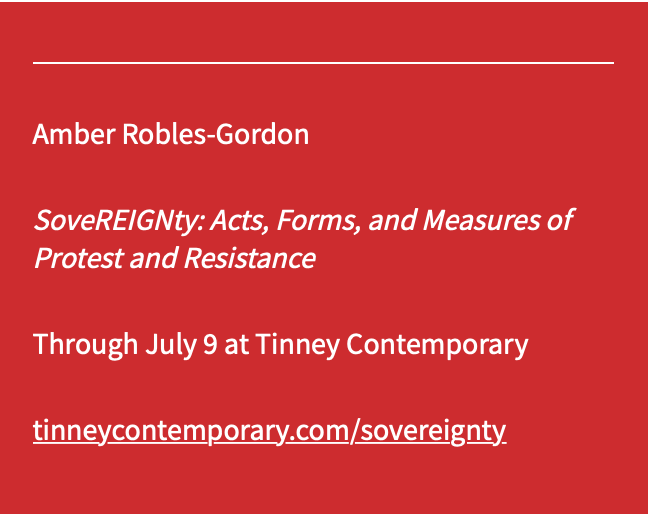SoveREIGNty: Acts, Forms, and Measures of Protest and Resistance is currently on view at Tinney Contemporary
Joe Nolan
June 15, 2022
“Guam Political,” Amber Robles-Gordon
Tracking art-world trends often means simply noting the shifting balance between form and content over time. Midcentury American painting was formalist, elemental art for art’s sake. It was interested in line, shape, space, form, tone, texture, pattern, color and composition. An important work of art was something, but nowadays an important work of art is often aboutsomething: politics, social causes, various identity expressions.
https://www.tinneycontemporary.com/sovereignty
Midcentury art favored abstraction over figuration, but contemporary art is full of figures along with the narrative content they inevitably inspire. Luckily, no matter how the trends swing, we can always look back to the Greeks and remember that there is beauty in balance. And it’s not surprising that some of today’s best art manages to message and signal and narrate after first capturing the eye, drawing attention, and igniting the imagination of the viewer.
Even the title of Amber Robles-Gordon’s Tinney Contemporary exhibition — SoveREIGNty: Acts, Forms, and Measures of Protest and Resistance — expresses an activist message. And it’s emblematic of a display of large-scale, mixed-media quilts brimming with signals and symbolism interrogating U.S. policy toward — and governance of — its populated territories and the District of Columbia.
Robles-Gordon’s work highlights how outsized the emphasis on content has become in contemporary art. It’s also a good example of how unique abstract compositions — featuring compelling combinations of materials — can actually appeal to eyes and capture viewers’ curiosities before sparking a conversation about sovereignty and statehood.
At Tinney, Robles-Gordon’s large quilts are suspended from the ceiling, which allows viewers to see both sides of the various works while they traverse the space like they’re navigating an archipelago. The exhibition design is both geographic and cartographic, putting viewers in mind of visiting each location, but also reminding them about the often dubious authorities who draw lines on maps where they stab flags into the earth. The designs evoke national flags and banners, forwarding the show’s colonial-exploitation narrative. But this show also reads like a display of abstract painting, full of lines and shapes and bold colors, arranged in the homemade textures of fabric and thread.
In the 1940s and ’50s, the American Abstract Expressionists, along with art critic Clement Greenberg, practically pushed content right off the map in favor of pure formalism. Greenberg’s 1939 essay “Avant-Garde and Kitsch” drew a formalist line in the sand, demarcating the boundaries that came to define American midcentury painting: Modernism is inward-looking and self-critical — art about art; the best painting is unique, two-dimensional and flat; abstraction is more advanced than figuration.
But that was before identity, politics and social justice crashed the contemporary art world at the 1993 Whitney Biennial. The exhibition was the breakthrough point for an emerging generation of artist-activists like Daniel Joseph Martinez, Robert Gober and Byron Kim, who ignited conversations about race, sexual orientation and AIDS in galleries and museums, paving the way for much of the American art of the early 21st century. Now, 80 years after Greenberg’s essay was published, content rules.
One of the unique aspects of Robles-Gordon’s works is how she splits her designs between “political” and “spiritual” iterations on either side of her quilts. “Guam Political” features a palm tree design inside of concentric rings of turquoise, orange, green and yellow. The “political” sides of Robles-Gordon’s designs all resemble state flags or even picturesque license plate designs — idealized and bureaucratic. The “spiritual” designs on the other sides of her works all read more like Native handicraft compositions.
“Guam Spiritual,” Amber Robles-Gordon
Robles-Gordon achieves these looks by mixing and matching elements from national flags, Doppler radar images, Indigenous art, domestic ritual and references to the 1950s-’70s Washington, D.C. Abstract Expressionist art movement known as the Washington Color School.
The Washington Color School was also championed by Clement Greenberg. The movement rejected subject matter in favor of a purely formal investigation into color. Artists like Kenneth Noland, Morris Louis and Anne Truitt blazed a path beyond Abstract Expressionism while simultaneously pointing to the rise of minimalism. But at the same time, the group’s ideas were criticized as a dead end, incapable of engaging with the political and cultural tumult of the sexual revolution, the civil rights movement and the Vietnam War.
Robles-Gordon’s designs speak to sovereignty and social justice, environmentalism and colonial exploitation. They’re displays of traditionally feminine handicraft, and art activist amulets charged with symbolism and story. They’re jammed with identity messages and political criticism, but they’re also colorful compositions full of movement and energy, balanced in symmetrical, circular compositions — kind of meditative and a little iconic. Robles-Gordon wants to convey ideas and even ideologies, and she’s smart and talented enough to grab eyes first.



